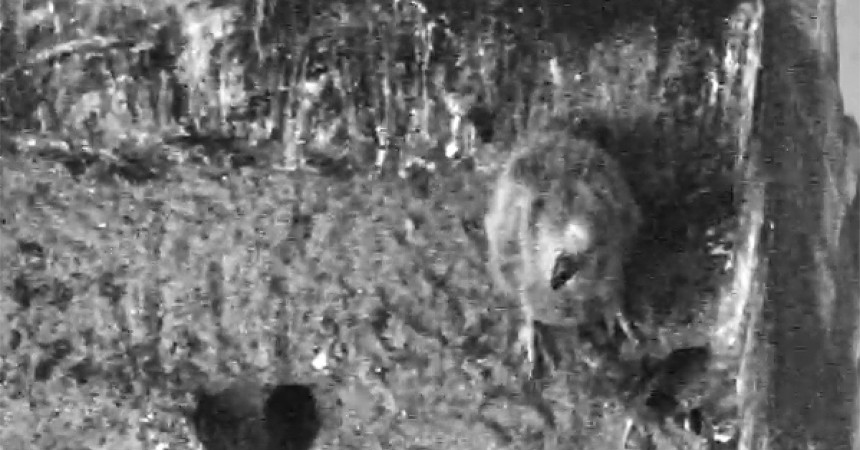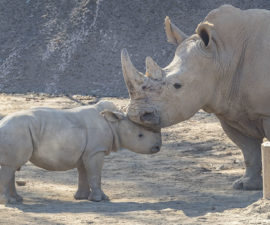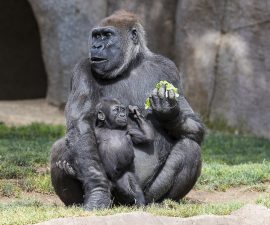At approximately one month of age, our California condor chick, Ackaw (pronounced “ACK-aw”), should weigh around 4.5 pounds (2 kilograms). The parents, Sisquoc and Shatash, may start leaving the chick alone overnight, sleeping near the nest. If the weather is still cool or it’s raining, the parents may continue to brood overnight until the weather improves. Even though the parents are increasing their time away from the chick, they remain VERY vigilant and protective of their nest and especially their chick. Some field biologists have even seen wild condor parents chasing black bears away from the nest area!
Up until now, the chick has been scooting around the nest on its tarsal joints. We refer to that as a “tarsal crawl.” It’s not uncommon at this age to see the chick standing all the way up on its feet, teetering about the nest, holding its wings out for balance. As its legs get sturdier, the chick may even approach the parent, begging for food. The “wing-begging” behavior we’ve been seeing will get more pronounced: lots of wing-flapping, head-bobbing, and trying to position itself in front of the parent.
It is possible that the parents, who are offering larger quantities of food per feeding session, might be providing a small amount of fur/hair in the chick’s diet. (Part of the adults’ diet includes mammals, like rats and rabbits.) Condors can digest just about every part of the animals they eat, except for fur. This fur accumulates in the digestive tract and is eventually regurgitated as waste. We refer to this as “casting.” A condor’s cast is composed of predominantly fur, whereas a cast from an owl has fur and bones; owls can’t digest bones, but condors can. We have seen condor chicks cast hair pellets as young as three weeks of age. When the chick casts, it throws its head forward several times with its mouth open, until the pellet is ejected. It can appear that the chick is in distress, but it is perfectly normal—and good for the chick.
At 45 days of age, the chick will get its first health exam. We will obtain a blood sample for the lab to make sure it is healthy and send a portion of this sample to a lab in the Genetics Division of the San Diego Zoo Institute for Conservation Research, located adjacent to the Safari Park. Geneticists will use the sample to determine if the chick is male or female. Also, during the exam, we will weigh the chick—it should weigh between 8 and 8.75 pounds (3.5 to 4 kilograms). We’ll also inject a transponder chip as a form of identification. It’s the same kind of chip you can get for your dog or cat at the veterinarian. Most importantly, the exam allows us to administer a vaccine for West Nile Virus. West Nile Virus is disease that originated in Africa and was accidentally introduced to North America by humans. North American wildlife, including condors, usually doesn’t have a natural immune response to West Nile Virus, so we are trying to give the chicks as much help as we can.
This exam will be the first time that Ackaw will see humans since being placed back in the nest after its rough hatch. It will naturally be disturbing, so we try to be as quick as we can be to minimize the disturbance; we aim for completing the exam within 9 to 10 minutes. Additionally, we will keep the chick covered with a towel to reduce its exposure to humans and to provide it a bit of security. We have to keep in mind that we don’t want the chick to become accustomed to or feel reassured by our presence; we want it to be a wild condor, uninterested and wary of humans, so that it may someday fly free in California, Arizona, or Mexico. Sisquoc and Shatash are usually away from the nest when we perform the procedure in order to keep them as calm as possible, as well.
Update May 18, 2016: Yesterday, at the San Diego Zoo Safari Park, the condor chick that has been viewable on the live condor cam was removed from the nest due to injuries it sustained in an interaction with the adult female parent that had been caring for it. Although medical care was given to the chick immediately it was determined that the injuries were severe enough that it would not recover and animal care staff made the difficult decision to euthanize it. A great deal is still not known about this species and there is no way to know why the chick became a target of the adult’s aggression at this time.
The California condor program has been very successful over the years, producing 192 chicks to date. There are 4 chicks currently being raised at the Safari Park.
Ron Webb is a senior keeper at the San Diego Zoo Safari Park. Read his previous blog, Condor Chick-Watching: Hatch to 1 Month.





